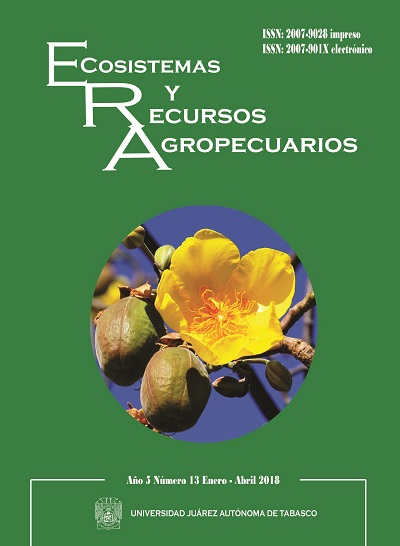Genetic diversity in apple tree cultivars established in the Sierra de Arteaga, Coahuila, Mexico
DOI:
https://doi.org/10.19136/era.a5n13.1276Keywords:
ISSR, polimorfismo, coordenadas principales, conglomerados, Árbol de recorrido mínimoAbstract
Apple production in the Sierra de Arteaga, Coahuila is mainly based on the Golden Delicious cultivar. Production based on only a few cultivars represents a genetic risk, because if they are susceptible to a pest, disease or climate change much of this production would be lost if one or more of these conditions occurred. Foreseeing this situation, farmers have introduced different commercial apple cultivars, but there is little information about the genetic diversity among them. Therefore, the aim of this study was to estimate the rates of intraspecic genetic diversity of 12 different apple cultivars using inter-simple sequence repeat (ISSR) molecular markers. Employing nine ISSR primers, it was possible to identify 124 DNA bands, of which 63% were polymorphic, with genetic diversity of 0.24. Results suggest that these cultivars are adapted to the region's climate and can be utilized to increase the overall plantation area, in order not to depend on a single cultivar.
Downloads
References
Azofeifa-Delgado A (2006) Uso de marcadores moleculares en plantas: Aplicaciones en frutales del trópico. Agrnomía Mesoamericana 17: 221-242.
Calvo P, Carrera A, Poverene MM (2014) Genética de poblaciones y evolución. Variabilidad genética en poblaciones argentinas de manzano silvestre (malus sp.) con marcadores SSR. Journal of Basic and Applied Genetics 25: 227-251.
Carrasco B, Avila P, Pérez-Días J, Muñoz P, García R, Lavandero B, et al. (2009) Genetic structure of highland papayas (Vasconcellea pubescens (Lenné et C. Koch) Badillo) cultivated along a geographic gradient in Chile as revealed by Inter Simple Sequence Repeats (ISSR). Genetic Resources and Crop Evolution 56: 331-337.
Contreras de la Reé FJ, Vázquez Ramos JA (2010) Cultivares y mutantes de manzana para el sureste de Coahuila. Folleto para productores. Número14. INIFAP. Campo Experimental Saltillo. México 16p.
Di Rienzo JA, Casanoves F, Balzarini MG, Gonzalez L, Tablada M, Robledo CW (2008) InfoStat, versión 2008, Grupo InfoStat. Universidad Nacional de Córdoba. Argentina. 336p.
Gayle MV, Chao CT, Norelli J, Brown SK, Fazio G, Peace C, McFerson J, Zhong GY, Bretting P (2015) The vulnerability of US apple (Malus) genetic resources. Genetic Resources and Crop Evolution 62: 765-794.
Granados SGF, López Ríos MA, Hernández GMA (2009) Recursos genéticos, biotecnología y propiedad intelectual. Revista Chapingo Serie Ciencias Forestales y del Ambiente 15: 127-140.
He P, Li L, Li H, Wang H, Yang J, Wang Y (2011) Genetic analysis of wild apple resources in Shandong province based on inter-simple sequence repeats (ISSR) and sequence-speci c ampli cation polymor- phism (S-SAP) markers. African Journal of Biotechnology 10: 9501-9508.
Kalkisim O, Okeu M, Okcu Z, Karabulut B, Yildirim N, Agar G (2016) Relationships among some pears genotypes (Pyrus Communis L.) based on ISSR and RAPD analysis. Erwerbs-Obstbau 58: 259-264.
Lado B, Poland J, Belzile F, Del Pozo A, Matus I, Rodríguez A, et al. (2012) Genotipado por secuenciación del genoma de 384 genotipos de T. aestivum para selección genomica. Journal of Basic & Applied Genetics 23: 267.
Pan H, Yang CH, Wei Z, Jiang J (2006) DNA extraction of birch leaves by improved CTAB method and optimization of its ISSR system. Journal of Forestry Research 4: 298-300.
Parvathaneni RK, Natesan S, Devaraj AA, Muthuraja R, Venkatachalam R, Subramani AP, et al. (2011) Fingerprinting in cucumber and melon (Cucumis spp.) genotypes using morphological and ISSR markers. Journal of Crop Science and Biotechnology 1: 39-43.
Prasanta KK, Srivastava PP, Awasthi AK, Urs SR (2008) Genetic variability and association of ISSR markers with some biochemical traits in mulberry (Morus spp.) genetic resources available in India. Tree Genetics And Genomes 4: 75-83.
Ríasco JJ, Victoria JI, Angel F (2003) Diversidad genética en variedades de caña de azúcar (Saccharum spp.) usando marcadores moleculares. Revista Colombiana de Biotecnología 1: 6-15
Rizkalla SA, Attia A, El-Hady A, Hanna NS, Nasseef JE (2012) Genetic diversity based on ISSR and protein markers associated with earliness trait in wheat. World Applied Sciences Journal 20: 23-33.
Savelyeva EN, Kudryavtsev AM (2015) AFLP analysis of genetic diversity in the genus Mallus Mill. (Apple). Russian Journal of Genetics 10: 1126-1133.
SIAP (2016) Servicio de Información Agroalimentaria y Pesquera. Producción anual de manzano. Cierre de la producción aagrícola de manzana por estado para el año 2014, modalidad riego más temporal. http://infosiap.siap.gob.mx/aagricola_siap_gb/ientidad/index.jsp. Date consulted: March 13, 2017.
Singh S, Karihalloo JL, Gaikwad AB (2007) DNA ngerprinting of some mango (Mangifera indica L) cultivars using anchored-ISSR markers. Journal Plant Biochemisty and Biotechnology 2: 113-117.
Smolik M, Krzysztoszek O (2010) Evaluation of genetic variability in chosen apple (Malus × domestica Borkh.) cultivars by ISSR-PCR analysis. Russian Journal of Genetics 46: 923-931.
Woodham-Smith C (1991) The great hunger: Ireland 1845-1849. 2nd edition. Penguin Books. London England. 521p.
Downloads
Published
Issue
Section
License
Aviso de copyright
Los autores que se envían a esta revista aceptan los siguientes términos:
una. Los autores conservan los derechos de autor y garantizan a la revista el derecho a ser la primera publicación del trabajo con una licencia de atribución de Creative Commons que permite a otros compartir el trabajo con un reconocimiento de la autoría del trabajo y la publicación inicial en esta revista.
B. Los autores pueden establecer acuerdos complementarios separados para la distribución no exclusiva de la versión del trabajo publicado en la revista (por ejemplo, en un repositorio institucional o publicarlo en un libro), con un reconocimiento de su publicación inicial en esta revista.
C. Se permite y se anima a los autores a difundir su trabajo electrónicamente (por ejemplo, en repositorios institucionales o en su propio sitio web) antes y durante el proceso de envío, ya que puede conducir a intercambios productivos, así como a una cita más temprana y más extensa del trabajo publicado. (Consulte El efecto del acceso abierto).


